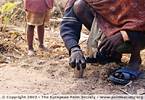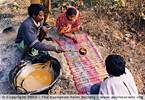 Khéjur-gur
Khéjur-gur
(page 4)


After the tree has remained for a few days thus
exposed, the tapping is performed by making a cut into this exposed
surface, in the shape of a very broad V, about three inches across
and a quarter or half inch deep. Then the surface inside the angle
of the V is cut down, so that a triangular surface is cut into the
tree. From this surface exudation of the sap takes place, and caught
by the side of the V, it runs down to the angle where a bamboo of
the size of a lead pencil is inserted in the tree to catch the dropping
sap and carry it out as by a spout. The tapping is arranged, throughout
the season, by periods of six days each. On the fist evening a cut
is made s just described, and the juice is allowed to run during
the night. The juice so flowing is the strongest and best, and is
called jirran juice. In the morning the juice collected in a pot
hanging beneath the bamboo spout is removed, and the heat of the
sun causes the exuding juice to ferment over and shut up the pores
in the tree. So in the evening a new cut is made, not nearly so
deep as the last, but rather a mere paring, and for the second night
the juice is allowed to run…."
I had carried this book with me and read out relevant
portions and translated it for Anand. He was not very impressed.
He did not follow a fixed pattern in letting the trees rest during
the harvest season. He said he just had a “feel” of a
particular tree’s productivity and would skip harvesting from
it and would resume again after a few days. I gathered that this
“feel” would come to Anand when he climbed the trees to
hang up the pots and studied the flow of sap as he scraped and pared
the cut on the tree and also from the quantity of sap the tree produced.
* * *
Anand and family having their morning meal when
we went to meet him. Anand left to work in his field. His wife offered
us fresh Phoenix sylvestris juice from the harvest brought down
by Anand in the morning. The sap in the narrow mouthed earthenware
pots had started to ferment as was apparent from the froth on the
surface. It was a pleasant tasting drink, but fresh in the early
morning it would have tasted fabulous. Now, around 10 a.m., it tasted
like a sweet but light beer.
continued on [next
page] [previous
page] [top]
[index]
|
 |
[an error occurred while processing the directive] |
